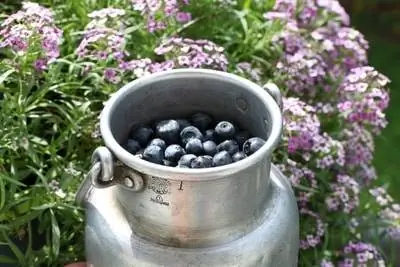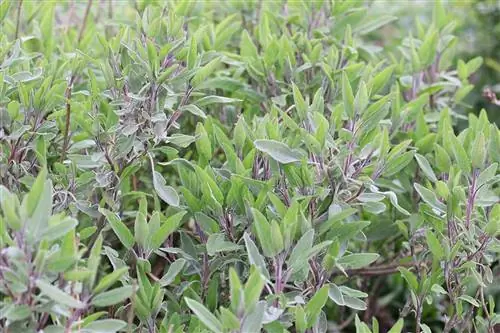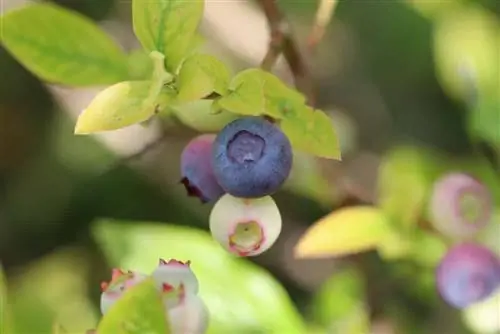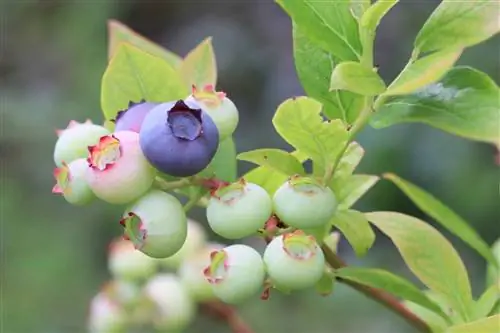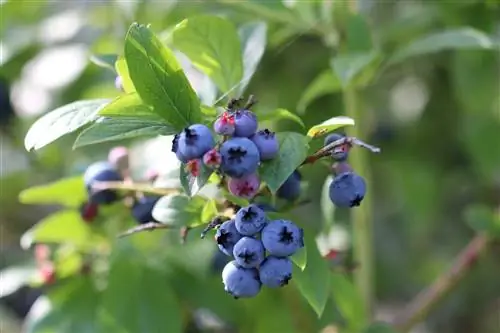- Author admin [email protected].
- Public 2023-12-17 03:39.
- Last modified 2025-01-24 12:45.
You definitely have to cut garden or cultivated blueberries at some point. Below you will find out how, the instructions also address the special requests of the most important breeding varieties. But you will also learn that you don't necessarily have to plant cultivated blueberries, but that there are "real, native blueberries" that also grow in the garden and, if in doubt, don't need to be pruned at all.
Cultivated blueberries need pruning care
In recent years, more and more blueberry bushes have been offered in garden centers and online shops for hobby gardeners because the demand for the blue berries has been showing an upward trend for years (which is due to the fact that the he alth value of blueberries is a recurring headline). good, you'll find out more about that).
These cultivated blueberries no longer have much in common with the blueberry plants from which we laboriously bend over to collect a few piercing blue berries with an intense aroma at the edge of the forest; Their ancestors also do not belong to the local plant world, but come from a foreign continent.
The cultivated blueberries go back to a few of the currently 265 blueberry species: The first cultivated plant was the American blueberry Vaccinium corymbosum, a blueberry with strong growth and a maximum height of up to 2 m, whose larger berries produce larger harvests. Other cultivated varieties emerged from crossings of V. corymbosum with the North American-Canadian V. angustifolium or other Vaccinium species, all of which reach completely different heights than the native dwarf shrub, grow stronger and bear more.
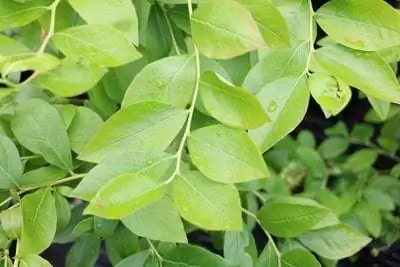
These cultivated blueberries naturally resemble the bushes that we usually plant in our gardens; Through breeding, perfect plantation blueberries were initially selected from the original American blueberry and its relatives. When the increasing popularity of the he althy berries led to more and more private home gardeners wanting to plant blueberries in their gardens, this demand was immediately met by commercial companies offering blueberry bushes grown for commercial cultivation to end consumers. These tall blueberry bushes are trained to produce plenty of full fruit wood every year and can do this best in the long term if they receive regular pruning.
Not every year, definitely not every shoot every year, because blueberries grow on two-year-old and older wood. The fruit quality is best on young, two- and three-year-old wood; at some point, the older wood no longer bears any fruit at all - annual pruning is recommended, so that with these bushes you must always try to cut out the oldest, woody shoots at a consistent rhythm. A few every year so that the plant stays young and vital and renews itself well from the base.
The best time for pruning is summer, after harvest; During the harvest, you can mark the shoots that are already decreasing in yield with colorful ribbons. A little attention and you will always have the bushes full of young shoots that develop good fruit quality.
In late winter you can make some improvements and remove old shoots or shoots that are growing too tightly. This does not mean the new shoots that grow upwards from the base to replace an old shoot; they will bear the best fruit in the next three years.
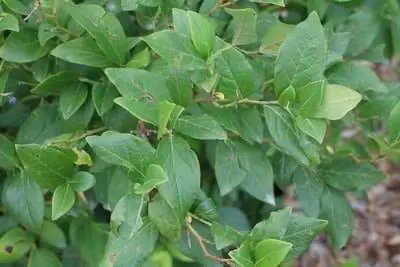
Tip:
If a sales description reads: “The blueberry plants in our shop should receive an annual pruning.”, it doesn’t just mean: “The blueberry plants from our shop” (the dealer gets the blueberries in his shop sure to prune it yourself), but it is formulated dangerously imprecisely with regard to the cut. Some customers then cut the blueberries back by half or more all around; like the multi-flowering shrub rose or the physalis on the house wall. No problem, the blueberry will continue to grow; However, after this “premature rejuvenation”, flowers and fruits will only appear again in the season after next.
All of this applies to adult blueberries in full yield. Until then, the blueberries will take their time - if you are dealing with young blueberry plants, they will be treated completely differently:
Cutting young blueberries
Blueberries are late bloomers and need 7-9 years to produce full yields. That's why specialist retailers usually sell early-grown blueberry bushes that are three to four years old, which may even be bearing their first fruits and are pruned after they've grown, as just described.
Blueberries are not only sold in specialist shops, but as trendy plants by all sorts of retailers - which makes it entirely conceivable that you have planted a very young blueberry in your garden. If, based on the circumstances of the purchase and the fact that the blueberry only shows a few flowers on the still low bush in the season after rooting, you suspect that you are dealing with a “baby blueberry”, you can use the young ones “Supporting blueberry bushes as they grow up”:
For the first four years, pinch off the flowers as soon as you can grab the bud. Then the plant doesn't have to spend part of its energy producing the few fruits (which don't make you very happy anyway), but can concentrate entirely on growing big and strong. Then when you let the flowers bloom in the fifth year, there will be a lot of flowers that produce a lot of berries.
Do the same thing with blueberry bushes that you have grown from sinkers, cuttings or cuttings. If “the little ones” show themselves to be lazy in branching, they are encouraged to branch by light all-round pruning during the budding period.
Breed varieties of cultivated blueberries and their pruning requirements
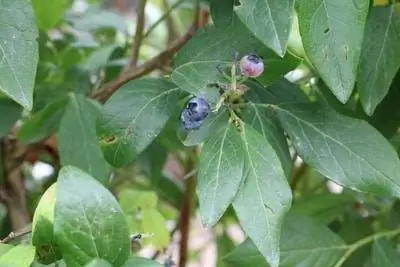
The following are the 10 best-known cultivars of cultivated blueberries that have special cutting requirements:
- Vaccinium corymbosum 'Blautropf' only grows to a height of approx. 50 cm and does not need to be cut at first. If at some point it “looks old” (tattered, partly bare shoots, declining yield), cut it back decisively after the harvest.
- Vaccinium corymbosum 'Blue Autumn',1 to 1.5 m, should be removed at regular intervals from old, visibly no longer vital shoots (distributed individually over the entire plant remove as described above).
- Vaccinium corymbosum 'Bluecrop' grows up to 2 m high, but tends to become bald in the lower area if it is not thinned out thoroughly every year.
- Vaccinium corymbosum 'Blue Dessert' ('Elizabeth') should be pruned in the same way as described above, just a little more conservative.
- Vaccinium corymbosum 'Blueroma' ('Darrow') grows vigorously and therefore has to be lightened by several shoots every year. If early frosts threaten, start pruning while the last fruits are ripening so that the bush can close the cuts before winter.
- Vaccinium corymbosum 'Bluesbrothers' should be removed every year from the oldest, visibly no longer vital shoots (remove them individually over the entire plant).
- Vaccinium corymbosum 'Brigitta Blue' Only one or two of the oldest shoots need to be removed per year.
- Vaccinium corymbosum 'Buddy Blue' is pruned like 'Blueroma' (despite its late maturity, it works without frost damage because the semi-evergreen tree can close cuts until winter and works well overall is frost resistant).
- Vaccinium corymbosum 'Duke' can be generously cleaned of old wood because it is known for good wood renewal from the base.
- Vaccinium corymbosum 'Little Blue Wonder' for area plantings, if at all, they are cut back completely.
Solve problems with cultivated blueberries by cutting them
The cultivated varieties of garden or cultivated blueberries have the same development history as other fruit varieties grown for commercial cultivation. Since the motives that determine breeding are the same - it's not about producing the best possible plants with highly aromatic fruits, but rather about plants that (their fruits) can be sold as well as possible to as many people as possible. Distribution to as many people as possible means distribution through mass retail. With the reassuring certainty that even defective substitute products (of an original whose properties they do not actually have) ornew products causing problems are implemented. There are enough uninformed and/or inexperienced consumers out there.
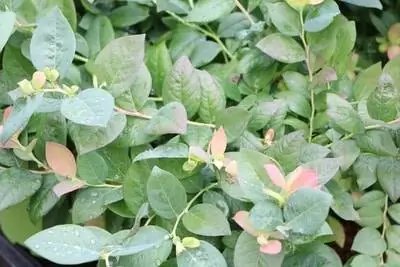
Because the commercially optimized uniformity of commercially grown fruits can only be achieved with breeding that, in return, always creates the same typical problems:
- The cultivars for commercial cultivation are more susceptible to disease than the species developed in nature
- In the case of imported species, they are at the mercy of native diseases/pests without a defense strategy
- “With a bit of luck” the diseases/pests will be imported with the foreign species
- The North American cultivated blueberry brought e.g. B. the Godronia shoot dieback and a gall midge called Prodiplosis vaccinii with
- When native diseases/pests encounter new species or foreign pathogens are imported, control is often difficult
- If the plant shows abnormal growth, the first step is always to remove the damaged parts of the plant
- The problem can be solved by disposing of them separately, but the trimming can also serve identification purposes
- The cultivated varieties for commercial cultivation often grow stronger than the natural species, but do not achieve their longevity (30-50 years)
- You therefore age faster and need a radical rejuvenation cut sooner
- The z. B. cut the bare bush down to around 30 cm in spring
- It is now rebuilding itself completely and will bear fruit again in the season after next
- Consultancy-free sales through the mass trade cause typical care errors among hobby gardeners
- Sometimes these care errors can be corrected by pruning the plant vigorously
- So with flowerless and fruitless growth, which can cause inappropriate nitrogen fertilization
- And in case of frost damage to a cultivated blueberry that did not get enough potassium before winter
- Or was planted in the wrong winter hardiness zone (blueberries from the Azores are also among the cultivated varieties)
- Even the blueberries in the wrong location are completely cut down before transplanting in autumn so that they can take root again in peace
Tip:
The blueberries of this world are good evidence that it makes sense to use botanical plant names as a guide (which initially seem like cumbersome word monsters, but you quickly get used to them). If you start looking into information about the cultivars of blueberries, you will inevitably come across original American sources - and then easily get confused because the American blueberry in the USA is their blueberry=blueberry, while the solid-colored European relative is Bilberry, Whortleberry or Whiniberry is called (“Huckleberry” is what the European and American species are called).
The problem-free blueberry (even when pruned)
Surely there are people who have to work a lot and there are people who are still very young; However uninformed and/or inexperienced consumers may be, it has been shown time and again that they are much smarter than solely profit-motivated companies assume (and that they resent it when insufficient information and/or inexperience are taken advantage of).
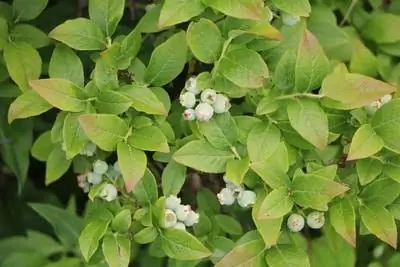
The gardeners among the consumers are definitely not all fans of cultivated blueberries, but many of them know that in addition to the blueberries from the garden center, there are completely different blueberries: our normal local blueberries, which come with American cultivated blueberries have little more in common than the genus; What they do not have in common is the influence of breeding, which is why they still develop their ingredients the way nature once produced them. These ingredients are what are meant when the he alth value of blueberries is invoked, leaves on low bushes and solid blue colored berries, which are listed when dried as “Myrtilli folium” and “Myrtilli fructus” in the European Pharmacopoeia.
Tip:
If you are now irritated because you have read that our local blueberries do not grow in the garden - now you get a clear impression of how incomplete information can be used to promote sales. That's not true; why should it, every plant grows away from the spot where the first of its kind took root - if it didn't do that, it wouldn't be available for purchase in the garden center (V. myrtillus: specialist nursery, tree nursery), but would be extinct. The articles that claim the opposite are mostly “disguised sales descriptions” for garden or cultivated blueberries, which then quite naturally point to the he alth effects of blueberries, which are actually only the ones from V.myrtillus-derived medicinal drug.
These he althy blueberries grow in the right location without much care in the garden; and their pruning is similarly unproblematic: If after a few years a rejuvenation of the constantly expanding old stand is desired, smaller stands are completely cleared of old wood and larger stands are subjected to a not too deep mowing. But it doesn't have to be, if you have enough space, just let Vaccinium myrtillus grow.

